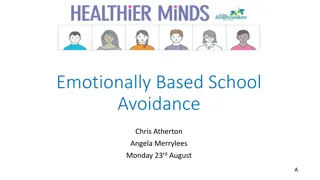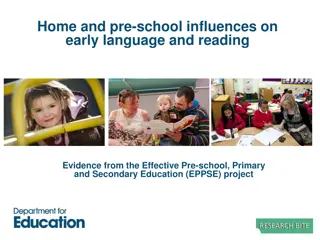Factors Affecting Children's Progress in Primary School
The data presented in the slides from Michael J. Rosenfeld at Stanford University for the testimony in DeBoer v. Snyder sheds light on various factors influencing children's progress through primary school. The analysis considers family type, household income, child's gender, metro status, householder's education, child's relationship to the householder, and child's race. The study determines if differences in progress remain significant after accounting for key factors such as parental income, education, child race, disability, gender, and state of residence.
Download Presentation

Please find below an Image/Link to download the presentation.
The content on the website is provided AS IS for your information and personal use only. It may not be sold, licensed, or shared on other websites without obtaining consent from the author.If you encounter any issues during the download, it is possible that the publisher has removed the file from their server.
You are allowed to download the files provided on this website for personal or commercial use, subject to the condition that they are used lawfully. All files are the property of their respective owners.
The content on the website is provided AS IS for your information and personal use only. It may not be sold, licensed, or shared on other websites without obtaining consent from the author.
E N D
Presentation Transcript
Michael J. Rosenfeld Stanford University Slides for testimony in DeBoer v. Snyder ED Mi #12-civ-10285
Table 1: What Factors Affect Childrens Progress Through Primary School? Does the difference remain significant after other key factors are accounted for ? % of students who have ever been held back in grades 1-8 Is the difference with the reference category statistically significant? Family Type Heterosexual Married (reference) Same-Sex Couple Single Women Single Men Heterosexual Cohabiters Children living in group quarters, non-inmates Group Quarters Inmates Child s Relationship to Householder Natural Born Child (reference) Adopted Child Step Child Foster Child Child s Race Asian American Non-Hispanic White (reference) Hispanic African American 6.8 9.6 11.1 11.4 11.7 34.4 78.0 7.4 10.6 13.9 20.6 5.8 6.8 9.0 12.6 -- yes yes yes yes yes yes -- yes yes yes yes --- yes yes -- No yes yes yes yes yes --- yes yes yes no --- no yes Source: U.S. Census 2000 microdata, via IPUMS, percentages reflect census weights. Statistical significance derived from weighted logistic regressions, see Rosenfeld (2010). All children had been living in the same place with the same parents for at least 5 years. Children include natural born children, step children, adopted children and foster children. The right hand column includes only natural born children. other key factors in the last column include parental income, education, child race, child disability, child gender, and state of residence. For children in group quarters or prisons, no parental information is known.
Table 1: What Factors Affect Childrens Progress Through Primary School?, continued % of students who have ever been held back in grades 1-8 Is the difference with the reference category statistically significant? Does the difference remain significant after income and other key factors are accounted for ? Household Income (1999 $) >100,000 (reference) 50,000-99,999 25,000-49,999 <25,000 Child s Gender Female (reference) Male Metro Status Suburban Urban Rural Householder s Education BA+ Some College HS degree <HS 5.3 6.1 8.7 12.6 6.5 9.0 6.0 8.6 10.3 4.4 6.3 8.7 14.3 --- yes yes yes --- yes --- yes yes --- yes yes yes --- yes yes yes --- yes --- yes yes --- yes yes yes Source: U.S. Census 2000 microdata, via IPUMS, percentages reflect census weights. Statistical significance derived from weighted logistic regressions, see Rosenfeld (2010). All children had been living in the same place with the same parents for at least 5 years. Children include natural born children, step children, adopted children and foster children. The right hand column includes only natural born children. other key factors in the last column include parental income, education, child race, child disability, child gender, and state of residence. For children in group quarters or prisons, no parental information is known.
Age at which students are making good progress for each school grade. Green arrows represent good progress, red dashed diagonal arrow represents probable grade retention. Typical age for student making good progress in Spring of the school year (the US census takes place in April) 6 7 8 9 10 11 12 13 14 15 Student Grade K 1 2 3 4 5 6 7 8 9
Allens Figure 2 Estimated grade level for 9 year olds, from actual 2000 Census data without controls, including 95% confidence intervals where visible, by family structure, plotted on the same grade scale as Allen s Figure 2 4 Traditional Same-Sex 3 Grade 2 Foster Children 1 0 8 9 10 Age Note: In the right hand figure, where actual data is used, the children of Traditional heterosexual married couples cannot be distinguished visibly from the children of same-sex couples, because at this scale the points overlap, and the 95% confidence intervals are, in fact, narrow. Note that even at this scale, one can see that foster children fall outside the 95% confidence interval of grade for children raised by same-sex couples. The data in the right hand side come from Table 2 of Rosenfeld s Supplemental report, with baseline rates of grade retention of 6.56% for children of Traditional heterosexual married families, 8.52% for children of same-sex couple families, and 21.46% for foster children. In Allen s expert report, he wrote (at point #26) What Rosenfeld actually found is represented in Figure 2.
Allens Figure 2 Estimated grade level for 9 year olds, from actual 2000 census data with controls, including 95% confidence intervals where visible, by family structure, plotted on the same grade scale as Allen's Figure 2 4 Traditional Same-sex 3 Grade Foster 2 1 0 8 9 10 Age Note: In the right hand figure, where actual data is used, none of the points can be visibly distinguished at this scale, because controlling for family income and education erases most of the differences between family groups in children s progress through school. The data in the right hand side come from Table 1 of Rosenfeld s Supplemental report, with estimated levels of grade retention of 6.56% for children of Traditional heterosexual married families, 7.49% for children raised by same-sex couples, and 12.70% for foster children. In Allen s expert report, he wrote (at point #26) What Rosenfeld actually found is represented in Figure 2.
Allens Figure 2 Estimated grade level for 9 year olds, from actual 2000 census data with controls, including 95% confidence intervals, by family structure, zooming in to a more appropriate grade scale 3.000 Traditional 2.950 Same-Sex with 95% confidence interval Grade 2.900 Foster children with 95% confidence interval 2.850 2.800 8 9 10 Age Notes: The entire figure on the right would occupy only a small part of the scale on the left. The confidence interval for foster children is entirely outside the confidence interval for children of same-sex couples. Children of traditional families do not have a confidence interval because their uncertainty is built into the confidence intervals for the other two groups, which are compared to traditional. The traditional and same-sex groups are less than 1% of one grade level apart, and the children from traditional families fall within the confidence interval of the children raised by same-sex couples. The data in the right hand side come from Table 1 of Rosenfeld s Supplemental report, with estimated levels of grade retention of 6.56% for children of Traditional heterosexual married families, 7.49% for children raised by same-sex couples, and 12.70% for foster children. In Allen s expert report, he wrote (at point #26) What Rosenfeld actually found is represented in Figure 2.
Allen, Douglas W., Catherine Pakaluk, and Joseph Price. 2013. "Nontraditional Families and Childhood Progress Through School: A Comment on Rosenfeld." Demography Adds to Rosenfeld s models the children whose family at the time of their progress through school was unknown. Adds the adopted, step, and foster children, even though it is well established that the same-sex couples are more likely to adopt children with special needs.
Allen, Douglas W. 2013. "High School Graduation Rates Among Children of Same- Sex Couples." Review of Economics of the Household The Canadian subjects were ages 17-22, and the Canadian census data only has information on family stability going back 5 years. Before ages 12-17, nothing is known about who the child was living with. This is important because educational problems tend to emerge well before high school. Adopted children are not distinguished from biological children in the Canadian census. This is important because adopted children tend to have poorer outcomes on average.
Regneruss 2012 How Different are the Adult Children of Parents Who Have Same-Sex Relationships using data from the New Family Structure Study (NFSS) Of the 236 subjects in the NFSS whose mother ever had a boyfriend or whose father ever had a girlfriend, only 75 subjects ever lived with same-sex couples; of those 75, only 3 lived the full 18 years with same-sex couples. Even among the 75 subjects who ever lived with same-sex couples, the average of years lived with same-sex couples was less than 4 years. Relevance: The same-sex couples identified in the NFSS were formed in the mid 1990s (at median), and we know nothing about whether the same-sex couples involved considered themselves to have been in committed, or in marriage-like relationships. For Regnerus s analyses, he compared the children of lesbian mothers or children of gay fathers to children of intact biological families who lived their entire childhoods in one stable family. He excluded from the comparison group all exclusively heterosexual parent families that had divorced or separated. This is important because family dissolution predicts poorer outcomes. Analysis of Regnerus's data shows that when family instability is taken into account, having a parent who had a same-sex relationship is not associated with worse outcomes.
Two typical NFSS cases of subjects with lesbian mothers (according to Regnerus s definition) and a substantial number of childhood family transitions, but the transitions were not due to the break-up of same-sex couples. Case 1) Subject #12231 18 year old female subject, Categorized by Regnerus as having had a lesbian mother. Years spent living with same-sex couple: 0 On public assistance growing up. Case 2) Subject #5409 24 year old female subject, categorized as having had a lesbian mother. Years spent living with same-sex couple: 2. On public assistance growing up. Age Status, or family transition Age Status, or family transition Biological mother and biological father, together At birth At birth Biological mother only Biological father moves in with biological mother age 5 Biological father moved out age 1 Biological father moves out; mother s girlfriend moves in age 6 Both grandparents moved in age 11 Subject moves from home of biological mother and mother s girlfriend, to biological father s house age 7 Both grandparents moved out age 13 Biological father moved back in with biological mother age 12 age 14 Biological father moved out again Employed part-time, receiving public assistance, has HS diploma, income less than $15,000, in a good relationship, heavy smoker, no arrests or convictions, no depression. Unemployed, receiving public assistance, 12th grade education (no diploma), light smoker. No arrests or convictions, no depression. Adult Outcomes: Adult Outcomes: Note: Outcomes are a subset of the outcomes reported on in Regnerus s 2012 paper using NFSS data.
Is there anything we can learn from the NFSS about the outcomes of children raised by same-sex couples? Controlling for family instability, lesbian mother and gay father families are not associated with negative outcomes for children. Even among the subjects who ever lived with a same-sex couple, the number of observed break-ups of same sex couples is small. Of all family transitions among subjects who ever lived with same-sex couples, only 7% of the transitions were directly due to the break-up of same-sex couples.
Determinants of couple stability for heterosexual married couples from the CDC s National Survey of Family Growth, a nationally representative study of women age 15-44, based on the most recent data from NSFG, reported in Copen et al (2012) divorce rate for first marriages after 10 years Note: All differences reported here are significant based on the standard errors reported in Copen et al (2012). Race Asian White African American 17% 32% 44% An additional factor not reported on in Copen et al is income. Bramlett and Mosher (2002) showed that, in an earlier cycle of NSFG data, heterosexual married couples with more than $50,000 of household income in 1995 had a 10 year divorce rate of 23%, compared to a 10 year divorce rate of 53% for heterosexual married couples with household income of less than $25,000. Age at First Marriage Under 20 Over 25 46% 22% Education less than HS BA or more 40% 15% Mother had children before the marriage no children yes children 29% 44%
Couple stability for same-sex couples compared to heterosexual couples. 1) Early research with data that predates the era of same-sex marriage: Kurdek, 1998. "Relationship Outcomes and Their Predictors: Longitudinal Evidence from Heterosexual Married, Gay Cohabiting, and Lesbian Cohabiting Couples." Journal of Marriage and the Family Blumstein and Schwartz. 1983. American Couples: Money, Work, Sex. 2) Recent European research, from older to more recent: Andersson et al. 2006. "The Demographics of Same-Sex Marriages in Norway and Sweden." Demography (with same-sex registered partnerships in Sweden in 1995-2002 less stable than heterosexual married couples). Ross et al. 2011. "Civil Partnership Five Years On." Population Trends (with same-sex civil partnerships having greater stability than heterosexual married couples in the UK, 2005-2008) 3) Research with the most recent US data tends to show that same-sex couples with formal unions have similar couple stability to heterosexual married couples: Balsam et al. 2008. "Three-Year Follow-Up of Same-Sex Couples who had Civil Unions in Vermont, Same-Sex Couples not in Civil Unions, and Heterosexual Married Couples." Developmental Psychology (Vermont civil unions with matched comparison set followed 2001-2004) Rosenfeld 2012. "Couple Longevity and Formal Unions in the era of Same-Sex Marriage in the U.S.," presented at the meeting of the American Sociological Association in Denver, Colorado. (nationally representative data, 2009-2011) Both Rosenfeld and Balsam et al show that the stability benefit of formal unions is comparable for same-sex and for heterosexual couples.
There is no evidence that the legalization of same-sex marriage has any negative effect on heterosexual couples. Examining state level data: Dinno, Alexis, and Chelsea Whitney. 2013. "Same Sex Marriage and the Perceived Assault on Opposite Sex Marriage." PLOS ONE Langbein, Laura, and Mark A. Jr. Yost. 2009. "Same-Sex Marriage and Negative Externalities." Social Science Quarterly Examining Individual level data: How Couples Meet and Stay Together (Rosenfeld s NSF-funded, longitudinal, nationally representative study) shows that heterosexual married couples were no more likely to divorce when living in a state that allowed same-sex marriage (0.85% divorce rate per year) compared to heterosexual married couples living in states that did not allow same-sex marriage (1.5% divorce rate per year).
Summary: Having same-sex couple parents is no disadvantage to children.
Table 1: What Factors Affect Childrens Progress Through Primary School? Does the difference remain significant after other key factors are accounted for ? % of students who have ever been held back in grades 1-8 Is the difference with the reference category statistically significant? Family Type Heterosexual Married (reference) Same-Sex Couple Single Women Single Men Heterosexual Cohabiters Children living in group quarters, non-inmates Group Quarters Inmates Child s Relationship to Householder Natural Born Child (reference) Adopted Child Step Child Foster Child Child s Race Asian American Non-Hispanic White (reference) Hispanic African American 6.8 9.6 11.1 11.4 11.7 34.4 78.0 7.4 10.6 13.9 20.6 5.8 6.8 9.0 12.6 -- yes yes yes yes yes yes -- yes yes yes yes --- yes yes -- No yes yes yes yes yes --- yes yes yes no --- no yes Source: Rosenfeld 2010, using Census 2000 data
Table 1: What Factors Affect Childrens Progress Through Primary School?, continued % of students who have ever been held back in grades 1-8 Is the difference with the reference category statistically significant? Does the difference remain significant after income and other key factors are accounted for ? Household Income (1999 $) >100,000 (reference) 50,000-99,999 25,000-49,999 <25,000 Child s Gender Female (reference) Male Metro Status Suburban Urban Rural Householder s Education BA+ Some College HS degree <HS 5.3 6.1 8.7 12.6 6.5 9.0 6.0 8.6 10.3 4.4 6.3 8.7 14.3 --- yes yes yes --- yes --- yes yes --- yes yes yes --- yes yes yes --- yes --- yes yes --- yes yes yes























